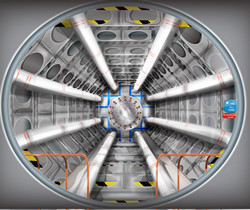Searching for new physics with charm
Scientists working on the EU-funded project CHARM@LHCB (Search for new physics in charm at LHCb) await new discoveries from an unexpected quarter, the LHC beauty (LHCb) experiment. Unlike A Toroidal LHC Apparatus (ATLAS) and the Compact Muon Solenoid (CMS), LHCb is a small experiment devoted to beauty quarks, or b quarks. But why does the LHCb experiment designed to catch b quarks have a good chance of discovering new physics? It has been found that certain processes governed by the weak interaction treat matter and antimatter differently. The standard model incorporates this phenomenon known as CP violation through the Cabibbo-Kobayashi-Maskawa (CKM) 'mixing' matrix. The CKM matrix describes the probability that a quark will change from one flavour to another when it interacts with the messenger particle of the weak force. Antiquarks are governed by the same matrix, but with all entries replaced by their complex conjugates. Since numbers in the CKM matrix have non-zero imaginary parts, quarks and antiquarks have different interactions. CHARM@LHCB partners focused CKM-related measurements involving charm hadrons. In their search for CP violation, they employed an innovative approach to describe the phase space of the three-body charmed meson decays. The measurements used had been collected by the Cleo detector, recording particles produced at the Cornell Electron-positron Storage Ring. The new analysis was based solely on experimental data rather than numerical simulations to assess the detector performance during the decay time of the meson. Project results suggest the existence of yet-undiscovered heavy particles that add new sources of CP violation in the early Universe. This supports current attempts to address the shortcomings of the standard model. Specifically, the problem is that the amount of CP violation provided by quarks is a billion times smaller than needed to generate the observed matter-antimatter asymmetry. The LHCb is likely to reach its peak performance sooner than ATLAS and CMS. The experiment has, therefore, a chance to discover first new fundamental particles that can be produced at the LHC.



